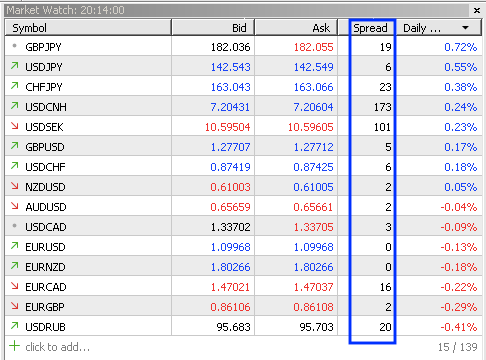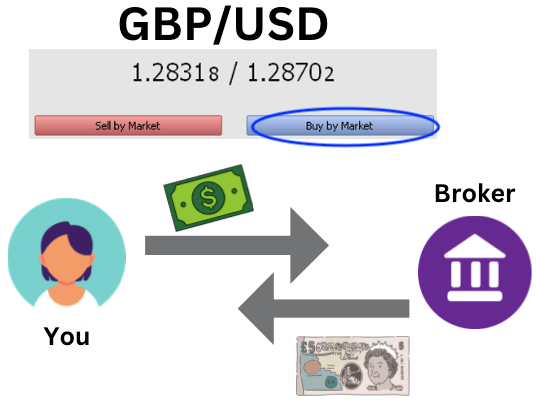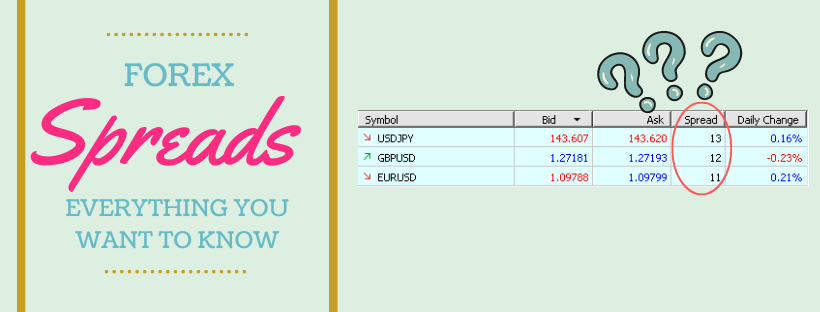You know that forex spreads are important.
The wider the spread, the more expensive it is to trade a currency pair.
But why it is that some currency pairs have much wider spreads than others?
And why do spreads change all the time?
In this blog post, we dive into the topic of forex spreads and answer questions like the above.
If you want to understand spreads once and for all: this is the place.
Let’s get started.
What is the spread in forex?
The spread is the difference between the buying price and the selling price.
For instance, when you look at a forex quote, you might see something like this:

This picture was taken from the GBP/USD currency pair.
It shows that you can sell the GBP/USD (sell pounds for dollars) at the rate of 1.28318 and buy the GBP/USD (buy pounds with dollars) at the rate of 1.28702.
The difference between these two rates is the spread. That is, 1.28702 – 1.28318 is 0.00384, or 38.4 pips.
(Read our guide on forex pips)
The price at which you can buy is also called the ask price and the price at which you can sell is also called the bid price. Hence, the spread is also known as the “bid-ask spread”.
The bid-ask spread in the above example is outrageously wide, but it is somewhat normal in the sense that the screenshot was taken on the weekend and spreads usually widen before the market closes (more on that later).
You can see the real time spreads in the Market Watch window, if you are using Meta Trader.

If you don’t see the spreads in there, you must add the view manually by right clicking inside the window, selecting Columns, and putting a tick mark next to Spread.
The spreads you see in Market Watch are expressed in digits.
This is usually 1/10th of a pip, so for instance, a 3 spread would mean a spread that is 0.3 pips wide, while a 24 spread would indicate a spread that is 2.4 pips wide.
You can always check to see what digits are applicable for the currency pair you wish to trade. Just right-click on the currency pair in Market Watch and select “Symbols” from the menu.
You will see the digits listed in the attributes box.

Why does the spread exist?
As we discussed above, the spread is the difference between the bid and ask prices.
To understand why there is spread, you must first understand why there are two prices for the same currency pair.
This can be traced to the problem of simultaneity in buying and selling securities.

Let’s assume you want to buy 1000 pounds with dollars.
Technically, you have no guarantee that a seller will be readily available in the market to trade with you.
The forex market, of course, is really active and you have a reasonable chance of finding a seller fairly quickly, but there are no guarantees.
Yet whenever you hit buy on GBP/USD, your transaction will be executed immediately.
How is that possible?
Well, usually it is because your forex broker is standing ready to execute your orders immediately.
They simply take the other side of your trades, so you don’t have to wait until someone with matching requirements come along.

It makes sense that the broker, who provides this market making service to you, would only agree to sell you pounds at a price slightly greater than they paid for them.
In a similar fashion, if you wanted to sell 1000 pounds, you would have no guarantee that there would be a buyer available in the market.
Hence the broker, who is providing this service immediately, will have to be compensated for doing so.
In this respect, the bid-ask spread exists as the “price of immediacy.”
Whenever the broker agrees to sell you an asset immediately, they want to sell higher than the market price, and whenever they agree to buy something from you immediately, they want to buy lower than the market price.
This results in the strange situation when instead of having one equilibrium price, we have two prices: the bid price and the ask price.
If buy and sell orders arrived at the same time, the market would clear at one equilibrium price and there would be no spread, but this is unfortunately not the case.
Why do spreads change all the time?
There are various factors that influence the spread at any given moment. It mostly boils down to brokers’ needs to manage risks and remain competitive, while also making money for themselves.
In the previous section, we explained that the spread is essentially the broker’s compensation for executing your trade immediately.
The great thing about forex is that it is huge and therefore, there is intense competition between different brokers which drives down the spread.
Simply put: if one broker demanded much bigger compensation for their service, they would start to lose clients.
That’s why forex spreads are normally very narrow. However, you probably noticed that spreads are not constant. They change all the time.

Some currency pairs have wider spreads than others, while even the cheapest currency pairs can go through periods of extremely wide spreads.
(Like the 38.4-pip spread we have seen with GBP/USD.)
To understand this phenomenon, we have to consider that there is a little more to spreads than simply charging a rather arbitrary (albeit competitive) price for market making.
In practice, brokers can face challenges when they stand ready to buy or sell currency pairs, because they must do so without going bankrupt.
Since buy and sell orders come at irregular times and for various quantities, brokers may need to adjust their bid and ask prices to ensure that the risk of bankruptcy is not too high.
For instance, studies investigating spreads have generally been able to show that spreads contain risk adjustment for inventory value uncertainty.
Consider a situation where a broker doesn’t want to increase his inventory further but is facing a high number of sell orders which he must fulfill (i.e., he must purchase the given currency from his clients).
The broker might decide to decrease his bid price and thereby discourage selling.
Remember the bid price is the price at which the broker will buy from you.
So, if you want to sell an asset, you’ll get the bid price, and the more the broker lowers it, the more likely you’ll be to wait until you get a better deal.

Hence, if the broker does not want to accumulate any more of an asset, for example, because they do not want to take the risk of holding it over the weekend, they may simply lower the bid price to curb the supply.
This will result in a wider spread.
Also, you might notice that some currency pairs have routinely wider spreads than others.
This is often the case when the pair in question is less liquid, meaning that it isn’t easily bought and sold since there aren’t enough market participants.
In this case, not only it is riskier for the broker to provide market making, but he also has to find a way to make some money despite the small trading volume.
Hence, he will widen spreads both as a risk premium and as a way to make profit.
By the way, liquidity itself is not constant. It can change throughout the day, which is another factor why you see spreads widen and narrow throughout the day.
How does the spread affect your profit?
The spread is a cost that decreases your profits.

You might have noticed that whenever you open a trade, it always starts from a slight loss.
Remember that you always buy higher than the market and sell below the market.
So, for instance, if the market price is 1.0010, the broker might give you 1.0011 as the buy and 1.0009 as the sell price (a 2-pip spread).
Let’s assume you open a long trade and close it immediately before the market moves.
You will first buy at 1.0011 and then sell at 1.0009, losing the 2-pip spread.
For example, you would buy 100,000 euros for 1.0011 * 100,000 = 100,110 dollars and then sell back the euros for dollars, that is, for 100,000 * 1.0009 = 100,090 dollars.
This is a loss of 2 pips, or 20 dollars in this case.
In essence, before you could make a profit, the market first always has to move a bit in your favor to cover the spread.
What is a good spread?
It goes without saying that you don’t want to overpay in spreads.
What counts as good spread, though, will depend on what currencies you trade.
Typically, major currency pairs will have narrow spreads while exotic pairs are more expensive to trade.
Here are some major currency pairs:
- EUR/USD: Euro/US Dollar
- GBP/USD: British Pound Sterling/US Dollar
- USD/CHF: US Dollar/Swiss Franc
- USD/JPY: US Dollar/Japanese Yen
And some exotic ones…
- USD/ZAR: US Dollar/South African Rand
- EUR/SEK: Euro/Swedish Krona
- AUD/SGD: Australian Dollar/Singapore Dollar
Brokers typically feature average spreads for different currency pairs on their websites, so that is a good place to get an idea about what spreads are normal for a given pair.

That said, as we already discussed, spreads change every moment based on various factors, such as how big the market is for the underlying currencies, or what external events there are that make market making riskier to the broker.
So, before you open a trade, it makes sense to always double-check if the spread you are getting is acceptable.
Typically, you will see that spreads are higher than normal during turbulent markets, before the weekend close, or during off-peak hours.
Since the forex market is decentralized, spreads can also vary from broker to broker.
For instance, it is possible that one broker might tend to have somewhat worse spreads than another, so you can shop around for the best forex broker; however, you should note that these differences are often negligible.
Conclusion
The spread is the difference between the bid price and the ask price.
It is the broker’s compensation for providing you with immediate access to the market. In other words, it is an expense for you that decreases your profits.
To avoid overpaying in spreads, you can check the average spreads for different pairs on your broker’s website. Then only trade when the spread is close to this average value.
It can also be a good idea to only trade major currency pairs, as these have the best spreads.


